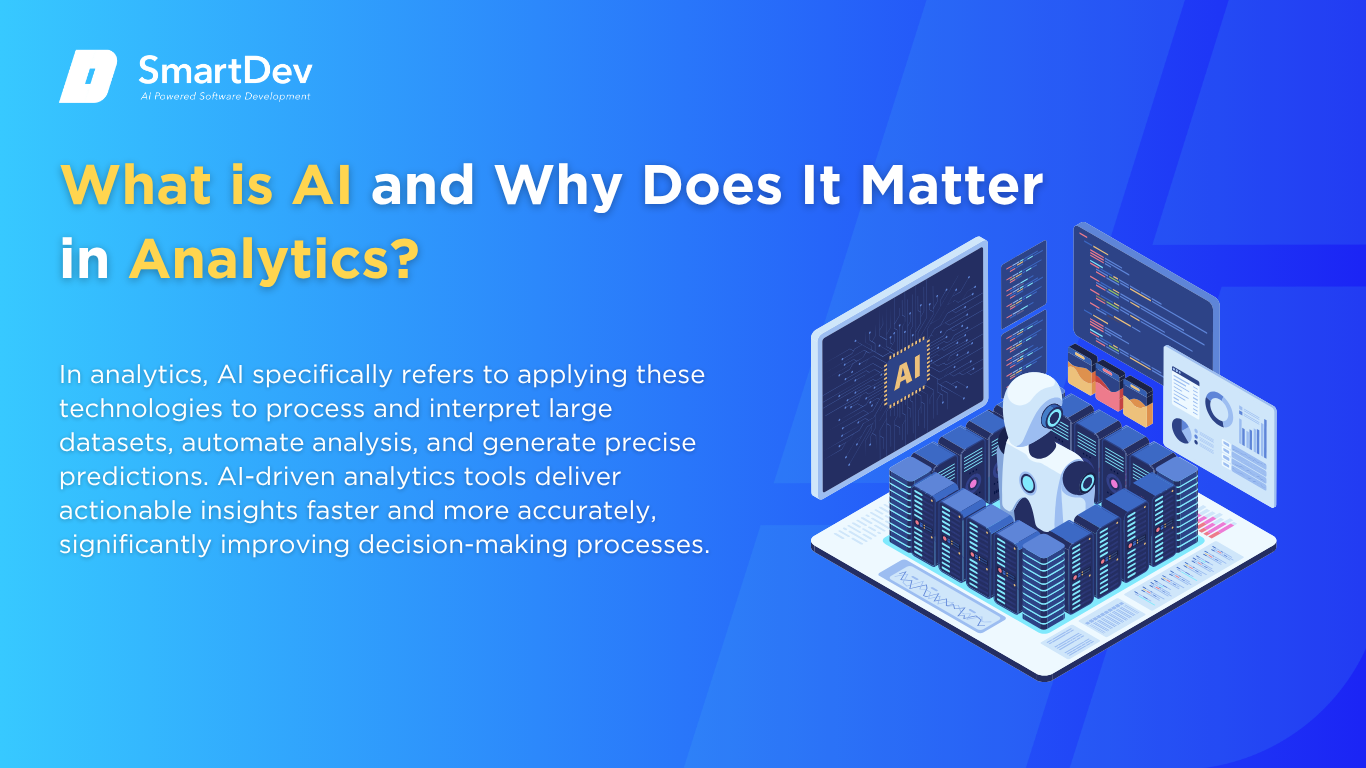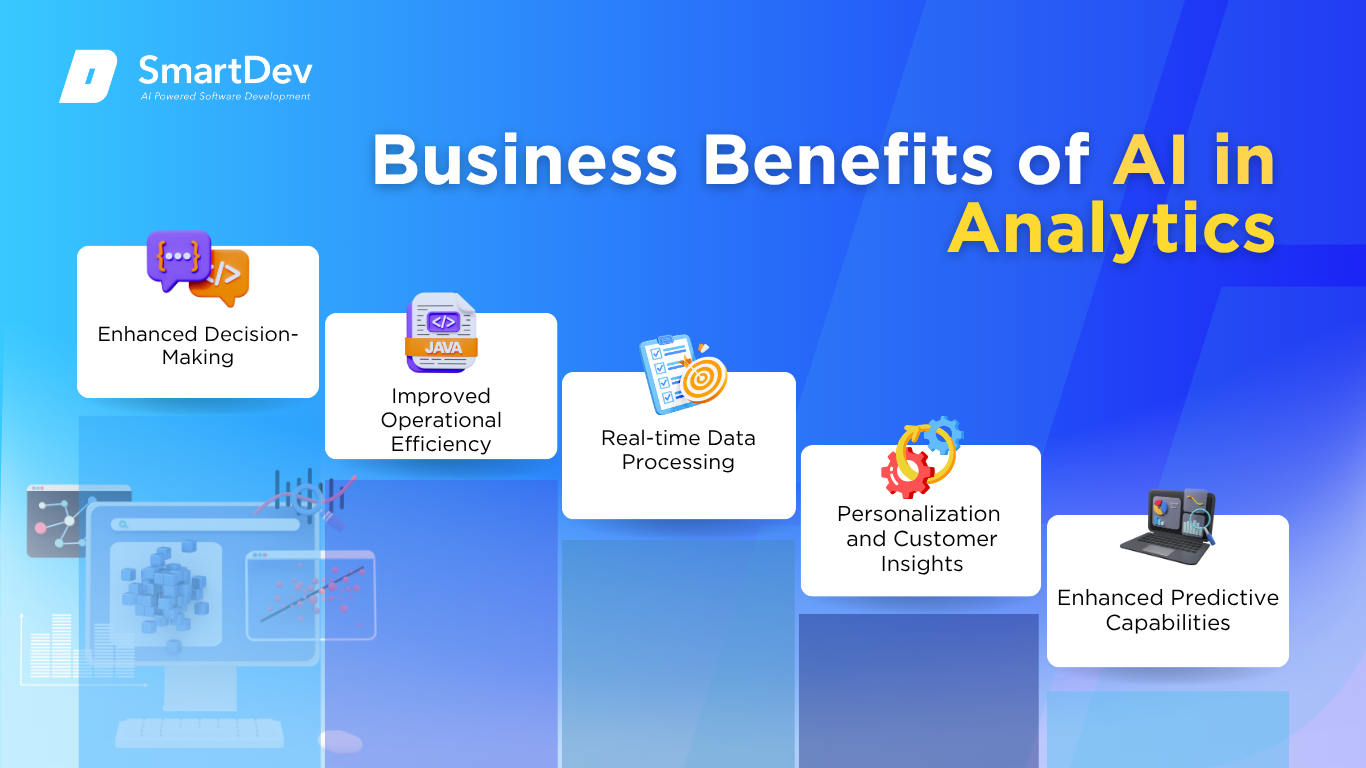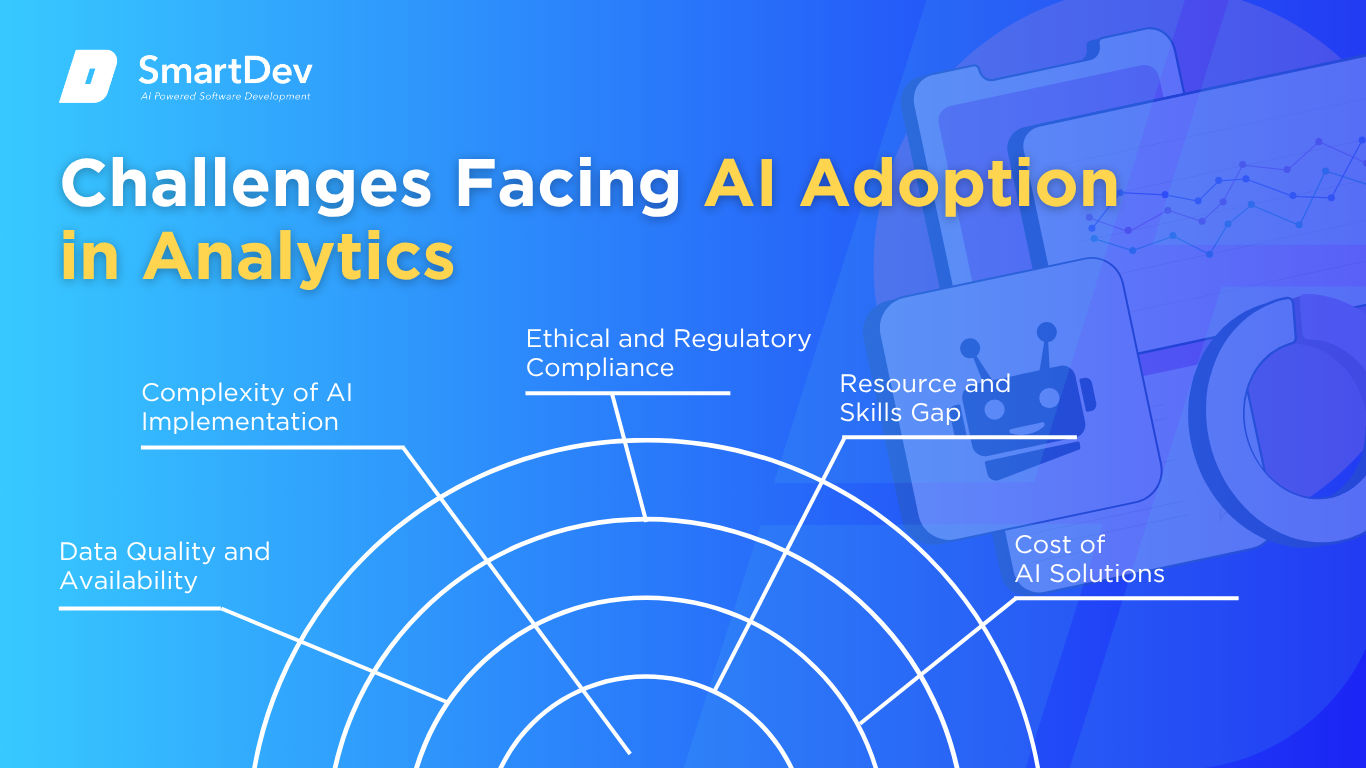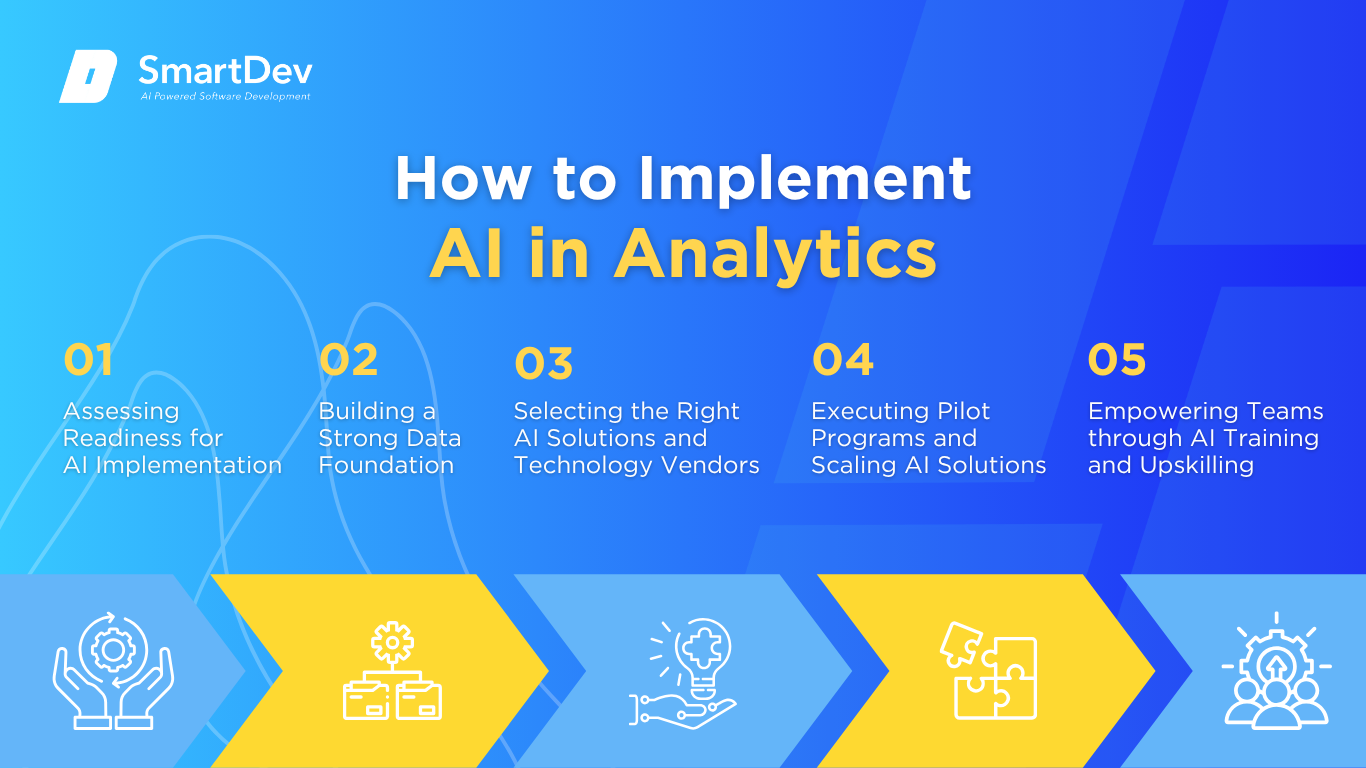Introduction
Businesses today face increasingly complex challenges—from processing vast amounts of data to making real-time decisions. Artificial Intelligence (AI) is transforming analytics by automating data-driven insights, predicting future trends, and enhancing strategic decision-making.
This comprehensive guide explores how AI reshapes analytics, delivering clear benefits and overcoming key adoption barriers.
What is AI and Why Does It Matter in Analytics?

-
Definition of AI and Its Core Technologies
Artificial Intelligence (AI) refers to computer systems designed to perform tasks that typically require human intelligence, learning, reasoning, sensing, and decision-making. According to IBM, this includes core technologies like machine learning (ML), natural language processing (NLP), and computer vision.
In analytics, AI specifically refers to applying these technologies to process and interpret large datasets, automate analysis, and generate precise predictions. AI-driven analytics tools deliver actionable insights faster and more accurately, significantly improving decision-making processes.
-
The Growing Role of AI in Transforming Analytics
AI reshapes analytics by enhancing the accuracy and speed of data processing. Companies increasingly use AI-driven algorithms to analyze massive datasets swiftly and accurately, replacing manual or traditional analytics methods. For instance, predictive analytics leveraging machine learning forecast future market behaviors and customer trends with unprecedented precision.
AI is also pivotal in real-time decision-making. Organizations can now harness real-time analytics powered by AI to rapidly adjust business strategies based on emerging trends or anomalies detected instantly. This capability is especially valuable in financial services, marketing, and supply chain management.
Additionally, AI-powered analytics tools are democratizing data across organizations. Advanced AI platforms with intuitive interfaces allow non-technical users to access complex analytics easily, empowering decision-makers at all organizational levels to leverage data-driven insights effectively.
-
Key Statistics or Trends in AI Adoption
-
The integration of AI in analytics continues to surge. Gartner predicts that by 2026, 70% of organizations will operationalize AI-based analytics to drive business outcomes, marking a significant increase from 30% in 2022. This rapid adoption underscores AI’s critical role in strategic decision-making across industries.
-
McKinsey highlights that businesses leveraging AI-driven analytics can boost profitability by up to 20% by streamlining processes and enhancing operational efficiency. This growth is primarily driven by AI’s ability to optimize resource allocation, predict market dynamics, and identify untapped opportunities rapidly.
-
The global AI analytics market is projected to reach $87 billion by 2030, growing at a CAGR of 28.8% from $11 billion in 2023, according to a recent report by Grand View Research. This significant growth trajectory highlights how integral AI has become to businesses seeking competitive advantages through analytics.
Business Benefits of AI in Analytics
AI drives substantial value in analytics by resolving critical issues like inefficiencies, data inaccuracies, and delayed insights. Here are five distinct benefits:

-
Enhanced Decision-Making
AI-driven analytics significantly enhance decision-making by providing deeper and more accurate insights. Machine learning algorithms quickly identify trends, anomalies, and correlations in data, enabling precise predictions and proactive decisions.
This capability addresses the challenge of uncertainty in business strategy by replacing guesswork with data-driven predictions, thereby reducing risk and enhancing confidence in decision-making processes.
-
Improved Operational Efficiency
AI analytics automate repetitive tasks like data cleaning and basic report generation, significantly improving efficiency. Organizations can redirect human resources toward strategic tasks requiring creativity and critical thinking.
For instance, financial institutions using AI-powered analytics streamline transaction monitoring and compliance processes, allowing quicker identification of potential fraud and reducing manual review efforts.
-
Real-time Data Processing
AI enables organizations to process and analyze data in real-time, offering immediate insights and responses to rapidly changing conditions. This is particularly critical in industries like retail and logistics, where immediate response times can directly affect profitability.
Real-time analytics powered by AI helps businesses swiftly respond to market fluctuations, consumer behaviors, and operational disruptions, maintaining agility and competitive advantage.
-
Personalization and Customer Insights
AI analytics provide deep insights into customer preferences, behaviors, and sentiments by processing vast amounts of data from various touchpoints. Businesses can deliver highly personalized customer experiences, improving engagement, satisfaction, and retention.
For example, retailers leverage AI-driven analytics to predict consumer preferences accurately and recommend tailored product offerings, significantly enhancing customer loyalty and sales.
-
Enhanced Predictive Capabilities
Predictive analytics powered by AI offer unprecedented accuracy in forecasting future trends, demands, and potential risks. Businesses can anticipate changes and proactively implement strategies to mitigate risks or capitalize on opportunities.
For example, AI predictive analytics are increasingly used in healthcare to forecast patient admission rates, improving resource allocation, reducing operational costs, and enhancing patient care outcomes.
Challenges Facing AI Adoption in Analytics
Despite its benefits, organizations face several barriers to fully adopting AI-driven analytics:

-
Data Quality and Availability
High-quality, accessible data is crucial for effective AI analytics, yet organizations often grapple with fragmented, incomplete, or poor-quality data. Without reliable data, AI models produce inaccurate insights or flawed predictions.
Addressing this requires significant investment in data governance, standardization, and integration across systems, demanding coordinated efforts between IT, analytics, and business units.
-
Complexity of AI Implementation
Implementing AI analytics solutions can be technically complex, involving advanced infrastructure, algorithm development, and integration into existing workflows. Organizations without robust technical expertise may struggle to fully leverage AI capabilities.
Effective adoption typically necessitates substantial technical investments or partnerships with specialized AI vendors, raising initial costs and complexity for businesses.
-
Ethical and Regulatory Compliance
AI analytics raise critical ethical and compliance concerns, particularly around data privacy, security, and algorithmic bias. Organizations must navigate stringent regulatory requirements, such as GDPR or HIPAA, complicating AI implementations.
Ensuring compliance often demands rigorous oversight, transparency in AI modeling, and continuous monitoring, adding layers of operational complexity.
-
Resource and Skills Gap
A significant barrier to AI adoption in analytics is the shortage of skilled professionals capable of developing, deploying, and managing AI systems effectively. Organizations struggle to recruit and retain talent with the requisite AI and analytics skills.
This talent gap may slow down or even halt AI initiatives, requiring investment in specialized training programs or strategic collaborations with educational institutions.
-
Cost of AI Solutions
The high cost of implementing AI analytics platforms can be prohibitive for many organizations, especially smaller businesses. Costs include infrastructure, software licensing, training, and ongoing maintenance, creating significant financial barriers.
To manage these expenses effectively, organizations may need to strategically phase their AI adoption, seek scalable cloud-based solutions, or consider partnerships to mitigate upfront investments.
By addressing these challenges head-on, organizations can fully realize the transformative potential of AI in analytics, ensuring sustained competitive advantages.
Specific Applications of AI in the Analytics

1. Predictive Analytics
Predictive analytics uses AI algorithms to forecast future outcomes based on historical data, solving the significant problem of uncertainty in business decision-making. This application employs machine learning models like regression analysis, decision trees, and neural networks to process vast amounts of structured and unstructured data. By integrating seamlessly with business intelligence platforms, predictive analytics generates insights that enable proactive rather than reactive decision-making.
Strategically, predictive analytics improves operational efficiency, reduces risk, and boosts revenue by anticipating market trends, customer behavior, and potential business threats. Despite its benefits, predictive models must be carefully managed to ensure transparency and mitigate biases. Ethical considerations around data privacy also need rigorous oversight to avoid misuse of sensitive information.
Netflix is a prominent example, effectively using predictive analytics to recommend personalized content to users. Leveraging Apache Spark and TensorFlow, Netflix analyzes viewing history and preferences, dramatically improving customer retention. The platform has reported saving approximately $1 billion annually through enhanced user engagement and reduced subscriber churn.
2. Customer Analytics
Customer analytics uses AI to interpret customer behaviors, preferences, and purchasing patterns, solving issues of low customer satisfaction and inadequate personalization. Techniques like clustering algorithms, sentiment analysis, and natural language processing (NLP) analyze customer interaction data gathered from emails, social media, CRM platforms, and web analytics tools. Integrated into marketing and customer service workflows, AI-driven customer analytics significantly enhances user experience.
This use case strategically enhances personalization, increasing customer loyalty, satisfaction, and lifetime value. However, businesses must remain vigilant about data security and GDPR compliance, as customer analytics often involves handling sensitive personal data. Ensuring ethical transparency and data privacy protection is paramount to maintaining customer trust.
Starbucks utilizes AI-driven customer analytics through its mobile app, using predictive models powered by Microsoft Azure. By analyzing customer purchasing habits and preferences, Starbucks offers personalized rewards and promotions. This strategy boosted revenue by an estimated 10% and significantly enhanced customer engagement and satisfaction.
3. Fraud Detection
AI-based fraud detection helps organizations swiftly identify and prevent fraudulent activities, solving the pervasive problem of financial losses due to fraudulent transactions. Using supervised machine learning methods like random forests and neural networks, fraud detection systems analyze transaction data, user behavior patterns, and anomalies in real-time. These systems integrate directly into payment processing and fraud investigation workflows, automating the detection and mitigation processes.
Operationally, AI-powered fraud detection significantly reduces response time, minimizes financial losses, and enhances the accuracy of threat identification. However, organizations must handle sensitive data carefully, ensuring data protection and adhering strictly to regulatory compliance standards. Additionally, regular auditing and updating of AI models are critical to address evolving fraud techniques.
PayPal exemplifies AI-driven fraud detection, leveraging advanced machine learning algorithms via its proprietary FraudNet platform. FraudNet processes billions of transactions to instantly detect unusual activity, significantly reducing fraudulent transactions. This system has reportedly lowered fraud rates by 50%, saving millions of dollars annually.
4. Workforce Analytics
Workforce analytics leverages AI to optimize human resource processes by providing insights into employee performance, retention risks, and productivity. Machine learning algorithms analyze data points such as employee feedback, performance reviews, and historical workforce trends. Integrated within HR management systems, AI-driven workforce analytics informs recruitment, training, and retention strategies.
The strategic value of workforce analytics includes enhanced employee retention, improved productivity, and optimized resource allocation. Organizations must handle employee data transparently to avoid ethical issues such as bias in performance assessments or promotions. Ensuring transparency and fairness in AI-driven decisions helps maintain employee trust.
IBM uses workforce analytics powered by its Watson platform to enhance employee retention and productivity. Watson analyzes performance data, engagement surveys, and training records to predict employee attrition risk. This proactive approach has reduced employee turnover by 15% and increased workforce productivity.
5. Marketing Optimization
Marketing optimization applies AI to improve the effectiveness of marketing campaigns, solving problems like wasted advertising spend and low conversion rates. AI techniques including reinforcement learning, predictive modeling, and sentiment analysis analyze marketing data from multiple channels to identify optimal advertising strategies. This technology integrates seamlessly into marketing automation tools and campaign management systems.
Strategically, AI-driven marketing optimization enhances ROI by accurately targeting audience segments, optimizing ad spend, and personalizing marketing messages. Nonetheless, organizations must remain vigilant about data privacy compliance and ethically transparent targeting practices. Continuous model refinement is crucial to ensure relevance and effectiveness.
Adobe’s AI tool Sensei optimizes marketing campaigns by analyzing vast datasets on customer interactions across digital platforms. Sensei identifies optimal campaign parameters, significantly increasing campaign ROI and customer engagement rates. Adobe has reported improved marketing effectiveness by approximately 20%, enhancing customer acquisition and retention.
6. Operational Analytics
Operational analytics utilizes AI to optimize operational efficiency, addressing issues like inefficiencies and productivity losses in business processes. Leveraging predictive maintenance models, optimization algorithms, and anomaly detection, AI analyzes operational data from IoT sensors, production logs, and process management tools. Integrated within enterprise resource planning (ERP) and operations management systems, AI enhances real-time decision-making capabilities.
The operational value of this application includes increased process efficiency, reduced downtime, and cost savings through predictive maintenance. Ethical considerations include ensuring robust data protection measures and fairness in automated decision-making. Continuous monitoring and updating of algorithms are essential to address changing operational conditions.
General Electric (GE) leverages AI for operational analytics using its Predix platform, which analyzes sensor data from industrial machinery to predict maintenance needs proactively. Predix’s predictive capabilities reduced downtime by 20% and cut maintenance costs significantly across GE’s manufacturing plants. This operational efficiency translates into substantial cost savings and improved asset reliability.
Whether you’re a COO looking to optimize analytics or a CTO aiming to digitize analytics, the future of analytics excellence starts with smart AI adoption. Explore custom AI solutions in predictive maintenance, robotic process automation, and analytics optimization at AI Solution Delivery. Talk to an AI expert at SmartDev to start automating your analytics today.
Need Expert Help Turning Ideas Into Scalable Products?
Partner with SmartDev to accelerate your software development journey — from MVPs to enterprise systems.
Book a free consultation with our tech experts today.
Let’s Build TogetherExamples of AI in Analytics
Real‑World Case Studies

1. Amazon: Customer Segmentation
Amazon, a global e-commerce giant, faced significant challenges in delivering personalized customer experiences amid massive user data volumes. The primary challenge was accurately identifying customer preferences from billions of interactions. Traditional segmentation techniques were insufficient, leading to irrelevant recommendations and lost sales opportunities.
To overcome these challenges, Amazon adopted AI-powered customer segmentation leveraging sophisticated machine learning models deployed through AWS SageMaker. By analyzing diverse datasets, including browsing history, purchasing patterns, and engagement metrics, Amazon generated detailed customer segments, each with unique characteristics and preferences. This deep segmentation enabled Amazon to provide highly personalized product recommendations and targeted marketing campaigns.
The implementation of AI-driven segmentation led to substantial improvements, including a 30% increase in recommendation accuracy and a 20% uplift in sales conversions. Enhanced personalization significantly boosted customer satisfaction and retention rates, reinforcing Amazon’s market leadership.
2. JPMorgan Chase: Fraud Detection
JPMorgan Chase, a leading global financial services firm, consistently grappled with the escalating risk of fraudulent transactions due to increasing digital banking activities. Traditional fraud detection methods generated excessive false positives, creating operational inefficiencies and poor customer experiences. The bank urgently needed a robust, scalable fraud detection solution to address these critical issues.
To address these challenges, JPMorgan Chase integrated supervised machine learning algorithms, specifically neural networks and decision trees, using the TensorFlow platform. These AI models analyzed transaction data, user behavior patterns, and historical fraud incidents in real-time, rapidly flagging suspicious activities and dramatically improving accuracy. The AI-driven system continuously learned from new data, adapting dynamically to emerging fraud patterns.
The AI implementation drastically reduced false positives by 60%, leading to significant operational cost savings and faster resolution times for fraud investigations. Improved detection accuracy strengthened customer trust and satisfaction, positioning JPMorgan Chase as a leader in secure digital banking.
3. Shell: Predictive Maintenance
Shell, one of the largest energy companies globally, faced persistent challenges with costly equipment downtime and unexpected maintenance needs across its global operations. Traditional maintenance scheduling was reactive, relying heavily on scheduled inspections and historical averages, leading to inefficiencies and higher operational costs. The need for a proactive and reliable maintenance strategy was clear.
To resolve these issues, Shell implemented predictive analytics leveraging Microsoft’s Azure AI services and machine learning algorithms. Shell equipped its infrastructure with IoT sensors collecting continuous operational data, which was analyzed in real-time to detect anomalies indicative of potential equipment failures. Predictive models identified maintenance needs before failures occurred, enabling proactive, data-driven maintenance decisions.
Adopting predictive maintenance drastically reduced equipment downtime by approximately 25%, translating to millions of dollars saved annually in maintenance costs. Enhanced operational efficiency allowed Shell to allocate resources more effectively, improving overall productivity and safety standards.
Read our detail project at An Advanced AI-integrated Speaking Application: Mastering the art of communication | SmartDev
Innovative AI Solutions
Emerging AI technologies continue to transform analytics by unlocking deeper insights and enhancing business decision-making capabilities. These innovations demonstrate the evolving potential of AI to revolutionize traditional analytics practices.
AI-driven automated machine learning (AutoML) platforms, such as DataRobot and Google’s AutoML, allow businesses to rapidly deploy sophisticated predictive models without extensive coding expertise. These platforms democratize analytics by making advanced predictive capabilities accessible to non-technical users, dramatically accelerating the analytics lifecycle.
Natural Language Generation (NLG) solutions, including platforms like Narrative Science and Arria, automatically convert data insights into clear, narrative reports. This capability transforms data into easily understandable formats, enabling faster and more informed decision-making, thereby significantly enhancing operational efficiency.
Edge AI analytics, utilizing platforms like NVIDIA’s EGX, perform complex data analyses directly on devices or at the network edge. This approach drastically reduces latency and bandwidth requirements, allowing businesses to make instantaneous decisions, especially beneficial in industrial and real-time environments.
To explore more the effective of AI adoption, you can find information about Our projects and solutions we’ve developed in collaboration with our valued clients.
AI‑Driven Innovations Transforming Analytics
1. Emerging Technologies in AI for Operations
Artificial intelligence (AI) is rapidly reshaping the analytics landscape. Generative AI technologies, like GPT-4 and DALL-E, are transforming how businesses generate insights and present data visually. These tools automatically create detailed reports, interactive dashboards, and compelling visuals, significantly reducing the time analysts spend on repetitive tasks. For example, Microsoft’s Power BI now leverages generative AI to produce narrative summaries alongside visual dashboards, enhancing comprehension and decision-making speed.
Meanwhile, computer vision has become critical for analyzing complex visual datasets. Industries ranging from retail to healthcare are utilizing computer vision algorithms to interpret images and videos, identifying patterns and anomalies that human analysts might miss. For instance, Walmart employs computer vision technology to monitor store shelves, automatically alerting employees about out-of-stock items, thereby optimizing inventory management and enhancing customer satisfaction.
2. AI’s Role in Sustainability Efforts
AI analytics is integral in sustainability efforts, particularly in reducing waste through predictive analytics. Businesses are leveraging machine learning algorithms to forecast demand with impressive accuracy, allowing them to minimize overproduction and reduce unnecessary inventory. Food retailers, such as Kroger, use AI-driven analytics to predict demand, substantially cutting food waste by aligning supply closely with consumer purchasing patterns.
Additionally, AI systems optimize energy consumption through intelligent analytics. Smart buildings, powered by AI, analyze occupancy patterns and environmental conditions to adjust heating, cooling, and lighting systems dynamically. Google’s DeepMind AI reduced energy usage in its data centers by 40%, showcasing the immense potential of AI-driven analytics in achieving sustainability goals.
How to Implement AI in Analytics

1. Assessing Readiness for AI Adoption
Determining your organization’s readiness for AI adoption involves examining existing analytics processes to identify areas where AI integration will add significant value. Start by analyzing tasks with high volumes of repetitive data analysis, such as reporting or anomaly detection, which are prime candidates for AI automation. It’s crucial to pinpoint clear business objectives—whether improving forecasting accuracy or automating data visualization—to guide your AI initiatives effectively.
Another critical step involves evaluating your technical infrastructure and data maturity. Organizations with robust data governance and advanced analytics capabilities will typically find smoother paths to AI adoption. However, even companies earlier in their analytics maturity can strategically implement AI, starting small to address specific, impactful use cases, gradually building toward broader capabilities.
2. Building a Strong Data Foundation
Implementing AI analytics successfully hinges on establishing a solid data foundation. Begin with meticulous data collection strategies, ensuring data is accurate, relevant, and comprehensive. Regularly cleanse your datasets to eliminate inaccuracies and inconsistencies, using automated tools like DataRobot or Alteryx to streamline this critical process. This preparation not only improves the quality of AI-driven insights but also significantly accelerates analytical processes.
Effective data management is equally critical. Implementing cloud-based solutions, such as AWS or Azure, enables scalable, secure, and efficient storage of large data volumes. Centralizing data management ensures easy access, improved collaboration, and better decision-making across your organization, laying the groundwork for successful AI analytics integration.
3. Choosing the Right Tools and Vendors
Selecting appropriate AI tools and vendors tailored for analytics demands careful evaluation. Begin by assessing specific business requirements against vendor offerings, prioritizing platforms that align with your goals, scalability, ease of use, and support services. Vendors like IBM Watson Analytics and Tableau integrate robust AI features specifically designed for intuitive, actionable insights, making them ideal for businesses seeking immediate analytical benefits.
Also, consider vendors that offer comprehensive training and support to ensure successful adoption. Partnering with vendors who understand your industry-specific challenges, such as SAS for healthcare analytics or Google Cloud for retail analytics, ensures a smoother implementation journey, ultimately enhancing AI’s effectiveness within your business.
4. Pilot Testing and Scaling Up
Starting with a small-scale AI pilot project is vital to mitigating risk and demonstrating initial value. Choose a specific analytics function, such as demand forecasting or customer churn prediction, and implement an AI solution in a controlled environment. This controlled rollout provides critical insights into operational feasibility, identifies unforeseen challenges, and clarifies adjustments needed before broader implementation.
Once the pilot demonstrates measurable success, scaling up requires careful planning. Gradually integrate AI across additional analytics processes, continuously monitoring performance and refining models. Companies like Netflix famously employ iterative scaling, progressively expanding AI-based personalization features, consistently enhancing viewer engagement and retention.
5. Training Teams for Successful Implementation
Ensuring successful AI adoption in analytics depends significantly on your team’s readiness and capability to work alongside these new technologies. Invest in comprehensive training programs designed to upskill employees, providing them with the necessary technical and analytical skills to leverage AI effectively. Training initiatives should cover essential areas like AI fundamentals, data interpretation, and ethical considerations surrounding AI use.
Building a culture that embraces continuous learning and adaptability is equally important. Encourage collaboration between AI specialists and analytics teams to foster mutual understanding and innovation. Successful organizations, such as Amazon, routinely host workshops and hackathons to strengthen AI competencies across departments, significantly enhancing adoption and performance.
Measuring the ROI of AI in Analytics
1. Key Metrics to Track Success
To accurately measure AI analytics ROI, prioritize key metrics such as productivity enhancements, evidenced by reduced time spent on manual analysis, and increased accuracy in forecasts or predictions.
Additionally, track cost savings resulting from automation, particularly in operational and labor expenses. By clearly comparing pre- and post-AI implementation metrics, businesses can quantify precise financial impacts and strategically guide future AI investments.
2. Case Studies Demonstrating ROI
An insightful example of AI analytics ROI is UPS’s route optimization program, ORION, powered by machine learning algorithms. By analyzing vast amounts of delivery data, ORION optimizes delivery routes daily, saving the company approximately 10 million gallons of fuel annually, translating into hundreds of millions of dollars in operational cost savings. Such tangible outcomes clearly highlight the transformative financial and operational impact of strategic AI analytics implementations.
Understanding ROI is possibly a challenge to many businesses and institutions as different in background, cost. So, if you need to dig deep about this problem, you can read AI Return on Investment (ROI): Unlocking the True Value of Artificial Intelligence for Your Business
3. Common Pitfalls and How to Avoid Them
One common challenge is underestimating data quality’s importance, leading to ineffective AI deployments. Businesses should emphasize rigorous data preparation and quality assurance as integral parts of the AI adoption process. Another pitfall is neglecting change management and employee buy-in. To avoid this, actively engage teams early, communicating transparently about AI’s benefits and providing continuous training to manage expectations and reduce resistance effectively.
Organizations must also avoid fragmented approaches by ensuring cross-functional collaboration and clear communication of AI goals and expectations across departments. Establishing dedicated teams responsible for AI implementation and monitoring ensures continuous alignment with organizational objectives and smooth integration.
Future Trends of AI in Analytics

1. Predictions for the Next Decade
In the coming years, AI analytics will become increasingly intuitive, driven by advanced natural language processing (NLP) and explainable AI models. Analytics platforms will enable business leaders to interact conversationally with data systems, obtaining precise, actionable insights instantly. Moreover, AI analytics will evolve toward greater autonomy, identifying and responding to business needs dynamically, significantly enhancing strategic agility.
2. How Businesses Can Stay Ahead of the Curve
To maintain a competitive edge, organizations must proactively monitor AI analytics developments, integrating new technologies swiftly. Businesses should foster innovation hubs dedicated to experimenting with emerging AI technologies, ensuring quick adoption of beneficial innovations. Regularly engaging with industry thought leaders and actively participating in AI-centric forums will further enhance foresight, keeping organizations well-informed and strategically positioned.
Conclusion
-
Summary of Key Takeaways on AI Use Cases in Pharma
AI analytics significantly enhances productivity, decision-making accuracy, and operational efficiency. With proper implementation strategies, including robust data management, vendor selection, and team training, businesses can realize substantial ROI from AI investments.
-
Call-to-Action for Businesses Considering AI Adoption
Now is the time for forward-thinking companies to embrace AI analytics. Evaluate your current analytics processes, identify high-impact opportunities, and start your AI journey today to drive innovation and secure competitive advantage in the increasingly data-driven marketplace.








